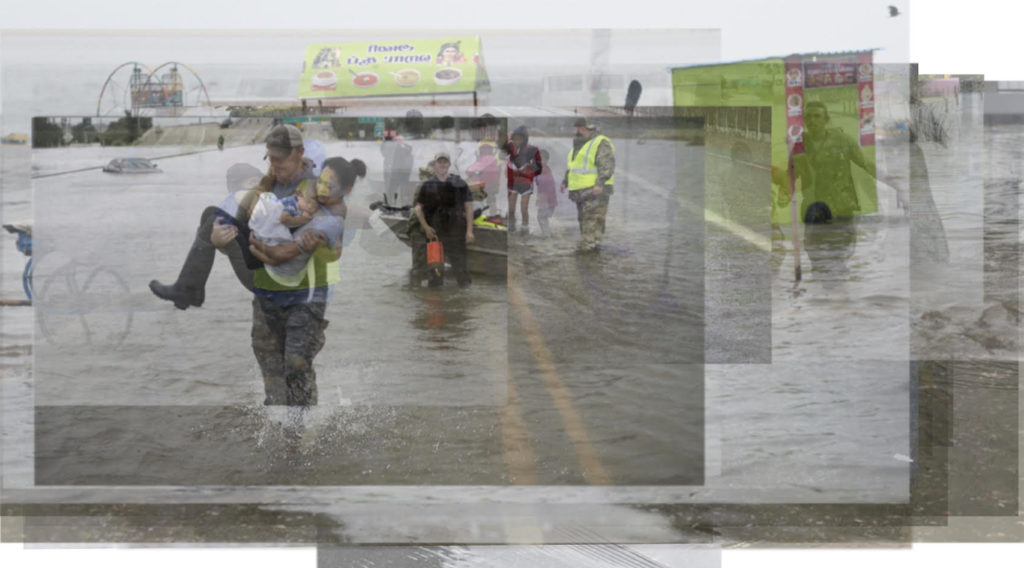I recently paid a visit to the Catharine Clark Gallery in San Francisco to see American Gothic, a collaborative exhibition by Deborah Oropallo and Michael Goldin. The mixed media work that comprised the show concerns their farm in Northern California and ecological issues, subjects which are obviously related and both of which Oropallo has addressed in her work over the past several years.
Although I’d previously seen at least one sculpture by Oropallo,1 I believe this is the first gallery show I’ve attended to feature such work. I’m not familiar with Goldin, but Oropallo’s aesthetic is so strong and makes such a seamless jump to the three-dimensional that it actually took some time before I realized I hadn’t before seen a show of hers largely made up of sculptural work.
Oropallo and Goldin’s piece American Gothic takes not only its title but its imagery from the Grant Wood painting, possibly the most recognized work in the history of American art. Wood’s two figures are gone, leaving only the farmer’s spectacles and his pitchfork, which now has a sewn rawhide handle replacing the functional wooden one. The Gothic-style farmhouse window from Wood’s piece appears as “reflections” in the lenses of the glasses. By encapsulating the composition in just these elements, Oropallo and Goldin have retained the “salt of the earth” allusion while opening up the image, making it less specific and more inclusive. The piece reimagines Wood’s painting in a manner that steps up the original slightly unsettling feel while also being informed by its common satirical reading and innumerable parodies.
Figuring prominently in the show are images of animals and objects from the farm. Bulls, boars, chickens, and especially sheep appear, or are at least conjured, as well as boots and buckets. Several of the three-dimensional pieces feature ducks; those in Crude and the Reflections series, covered in glossy or matte black resin, recall those horrible photos we’ve all seen of birds caught in the oil tanker spills which wreak havoc on our environment, both in the ocean and on land. In Dangling Ducks 1 and 2, the fowl appear to be burned and melting, their bills seemingly turning to liquid and dripping, as if in some darkly surreal animated cartoon.
I’ve been following Oropallo’s career for about thirty years, and her work continues to surprise. Even so, she is always building on her previous work, and certain motifs – her personal environment and the fairy tales in the present exhibition, for example – have appeared and re-appeared. This continuity was accentuated by the showing in the gallery of additional pieces, not part of this body of work, some dating back to the early 1990s. Snow White (1994) and Bad Apples (2016) both have Snow White-inspired imagery, as does the new HAVEAHART, a disturbingly humorous piece that has Snow White and all Seven Dwarfs caught in animal traps.2 Similarly, the painting Cloning Bo Peep from 2010 has echoes in BO PEEP, which evokes violence of some sort; taken by itself, I would assume against women, as so many fairy tales end badly for them. However, given the themes of the show, I think its subjects are industrial farming and animal cruelty.
Although in her video pieces Oropallo has been working with other artists for several years,3 I believe she has only recently started doing so outside of that medium.4 I presume she is attracted to the creative dialogue inherent in collaboration, which exposes her to different approaches, as throughout her career working alone, she has continually changed her techniques for making art. Like Robert Rauschenberg, she seems uncomfortable getting too comfortable – this has served her well; she has consistently produced engaging, challenging exhibitions, of which American Gothic was but the most recent.
1 Love + Marriage (2004), which celebrates the same-sex marriages that took place in San Francisco over twenty-nine days in February/March 2004, is on view at San Francisco City Hall, South Light Court.
2 The Haveahart® company makes humane catch and release animal traps, eight of which are used in the piece.
3 Three videos were shown in the Catharine Clark Gallery media room during the run of American Gothic. White as Snow, Wolf, and Dirty are all collaborations with Jeremiah Franklin, and take as their subject gender issues – another of Oropallo’s recurring interests, which she has also notably explored in the series Guise and Kink, among others.
4 To my knowledge, this is only the second time – Oropallo and Andy Rappaport, who have worked together on video pieces, produced the letterpress print DISARM in 2020.



